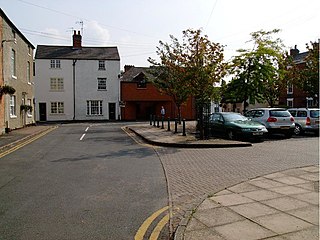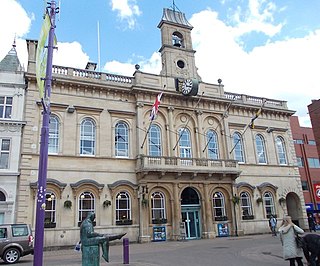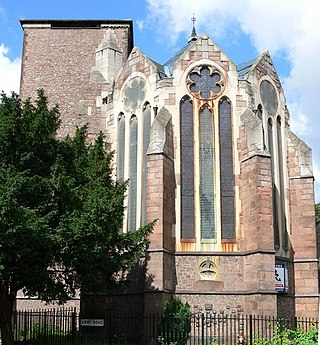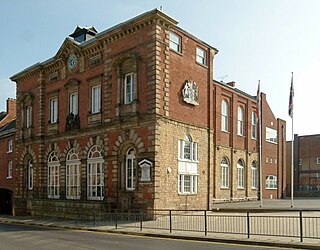
Belvoir Castle is a faux historic castle and stately home in Leicestershire, England, situated 6 mi (10 km) west of the town of Grantham and 10 mi (16 km) northeast of Melton Mowbray. The Castle was first built immediately after the Norman Conquest of 1066 and has since been rebuilt at least three times, the surviving structure, a grade I listed mock castle, dating from the early 19th century. It is the seat of David Manners, 11th Duke of Rutland, whose direct male ancestor inherited it in 1508. The traditional burial place of the Manners family was in the parish church of St Mary the Virgin, Bottesford, situated 3 mi (5 km) to the north of the Castle, but since 1825 they have been buried in the ducal mausoleum built next to the Castle in that year, to which their ancient monuments were moved. It remains the private property of the Duke of Rutland but is open to the general public.

Aylestone is a suburb of Leicester, England, southwest of the city centre and to the east of the River Soar. It was formerly a separate village, but the growth of the city since the Leicester Extension Act of 1891 incorporated Aylestone into the Borough of Leicester and it is now part of the suburban area.

Syston is a town and civil parish in the district of Charnwood in Leicestershire, England. The population was 11,508 at the 2001 census, rising to 12,804 at the 2011 census.

John Henry Manners, 5th Duke of Rutland KG, styled Lord Roos from 1778 until 1779 and Marquess of Granby from 1779 until 1787, was a British landowner as well as an owner and breeder of Thoroughbred racehorses.

The Corn Exchange is an events and concert venue located on Wheeler Street in Cambridge, Cambridgeshire, England. The building, which was commissioned as a corn exchange, is a Grade II listed building.

The Loughborough Town Hall is a building fronting onto the Market Place in Loughborough, Leicestershire, England. Built as a corn exchange and ballroom in 1855, it became a municipal building and subsequently a theatre. It is a Grade II listed building.

Garendon Hall was a country home near Shepshed, Leicestershire, England. It was demolished in 1964.

St Peter and St Paul's Church, Syston is a Grade I listed parish church in the Church of England in Syston, Leicestershire.

St Mary's Church is the Church of England parish church in Anstey, Leicestershire, in the Diocese of Leicester.
Frederick Webster Ordish FRIBA was an English architect based in Leicestershire.

St Paul's Church, Leicester is a Grade II listed former parish church in the Church of England in Kirby Road, Leicester, Leicestershire.

The Shire Hall is a municipal building in Fore Street, Hertford, the county town of Hertfordshire, England. The building, which currently serves as a Magistrates' Court, is a Grade I listed building.

Corn exchanges are distinct buildings which were originally created as a venue for corn merchants to meet and arrange pricing with farmers for the sale of wheat, barley, and other corn crops. The word "corn" in British English denotes all cereal grains, such as wheat and barley. With the repeal of the Corn Laws in 1846, a large number of corn exchanges were built in England, particularly in the corn-growing areas of Eastern England.

The Shire Hall is a municipal facility in Tindal Square in Chelmsford, Essex. It is a Grade II* listed building.

Catmose House is a municipal facility in Catmose Street in Oakham, Rutland, England. The house, which is the headquarters of Rutland County Council, is a Grade II listed building.

Worksop Town Hall is a municipal building in Potter Street, Worksop, Nottinghamshire, England. The town hall, which was the headquarters of Worksop Urban District Council, is a Grade II listed building.

March Town Hall is a municipal building in the Market Square in March, Cambridgeshire, England. The building, which was the headquarters of March Urban District Council, is a Grade II listed building.

The Church of St Mary the Virgin is a church in Ketton, Rutland. The Church of England parish church is a Grade I listed building.

Lutterworth Town Hall is a municipal building in the High Street in Lutterworth, Leicestershire, England. The structure, which operates as a community events venue, is a Grade II listed building.

The Shire Hall is a municipal building in Market Hill in Woodbridge, Suffolk, England. The structure, which is the meeting place of Woodbridge Town Council, is a Grade I listed building.




















